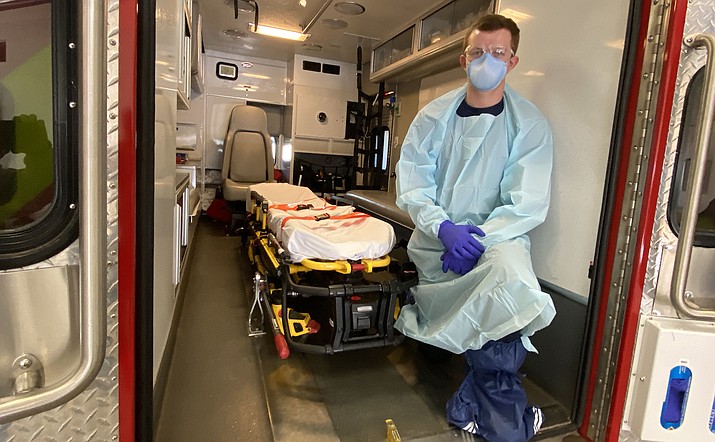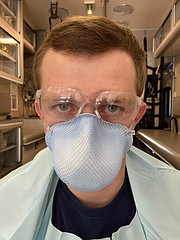Dealing with COVID-19: Just another day on the job for emergency service providers
VERDE VALLEY — With coronavirus dominating the national dialogue, it’s business as usual for Verde Valley emergency service providers.
The precautions everyone should take to prevent COVID-19 or any respiratory illness “are things that we do every day to protect the community from spreading illnesses and disease,” Copper Canyon Fire & Medical District Battalion Chief and EMT Chief Dan Elliott said Wednesday.
Because first responders are in contact with sick people each day, Copper Canyon personnel wear masks, eye protection, gowns and gloves to protect themselves and others from the continued spread of contagious illnesses.
But the degree of protection the department’s crews wear is dependent on the call, he said.
To combat the coronavirus, Copper Canyon first responders are using what they learned in training put on by the Arizona Department of Health Service Bureau of EMS – AZDHS.
“We are currently following their recommendations when it comes to what protective equipment first responders should be wearing, what symptoms they should be looking out for, and the proper decontamination of equipment and ambulances,” Elliott said.
Those recommendations, Elliott said, can be found at azdhs.gov and cdc.gov.
Standard operating procedure for Copper Canyon first responders to protect themselves and others from the coronavirus is that they “treat and transport the sick to a local hospital, while taking every precaution to not spread the illness,” Elliott said. “If crews were in fact exposed to the COVID-19 virus they would then be regulated to self-isolation at home for 14 days. At this time the COVID-19 test takes 24-48 hours to get results back.”
What is the coronavirus?
According to Copper Canyon Fire and Medical, there are many types of human coronaviruses, including some that commonly cause mild upper-respiratory tract illnesses.
However, COVID-19 is “a new disease, caused by a novel (or new) coronavirus that has not previously been seen in humans,” Elliott said. “The new COVID-19 illnesses have ranged from mild symptoms to severe illness and even death in some cases. COVID-19 is believed to spread mostly through respiratory droplets produced when a sick person coughs or sneezes.”
Cottonwood Fire and EMS
Cottonwood Fire Chief Mike Kuykendall also points to the preparedness and prevention protocol already practiced by his department every day.
He said the special suits that would likely be used if transporting a known COVID-19-positive patient are in the Cottonwood inventory, but would need to be re-supplied in a new way if the outbreak affects the Verde Valley in a major way.
Kuykendall believes the Verde Valley will have at least a few cases of COVID-19 before all is said and done.
“We put a mask on patients who show any of the listed symptoms of illness,” he said.
Sedona Fire and EMS
Since January, the Sedona Fire District has mandated that patient travel information be collected as a part of its patient history, according to Jayson Coil, the department’s assistant chief.
That’s but one of several protocols Sedona Fire – which also handles its own emergency medical services – is asking of its first responders. Others include:
• Dispatch center personnel asks questions to determine whether caller has signs or symptoms and risk factors for COVID-19.
• Environmental measures to reduce the potential for transmission have been implemented.
• Limited contact with anyone under investigation for COVID-19.
• Non-essential training and meetings are being evaluated on a case by case basis through a deliberate risk assessment process.
“We recognize that Sedona is an international destination preparing for an uncertain future, while doing everything we can to reduce the impact to our responders and those we serve,” Coil said.
Verde Valley Ambulance Company
Kim Moore, the EMS chief for the Verde Valley Ambulance Company, said she also thinks it’s just a matter of time until COVID-19 gets to the area. She said she won’t be surprised if not only there are some local cases, but also if Sedona turns out to be the route the virus makes its way into the rest of the Verde Valley. That city has considerably more international travelers than any other part of the Verde Valley.
“When we do facility-to-facility transports, we rely on medical personnel to give us the best and most recent information on each patient,” Moore said. “They want to protect themselves, too.”
Moore said the company reviews new statistics, protocol and recommendations every 24 hours. She said she’s grateful for the diligent screening of calls by dispatchers, whose information could make a huge difference in keeping first-responders, other medical staff and the public safe.
Moore said the COVID-19 outbreak has put on strain on the worldwide supply of many types of medical supplies and gear.
“Whatever we have now, that’s all we’ll have for a while,” she said.
Moore said her company’s crews are probably at more risk for infection at emergency sites, rather than on simple transport calls.
“In an emergency, a worker is far more likely to come into contact with a patient’s droplets,” she said.
Verde Valley Fire District
Verde Valley Fire District Chief Joe Moore said the information from health and infection control agencies seems to be updated frequently, so it’s important for him to push that out to field staff quickly.
“I issued two directives with new protocol, today alone,” Moore said the day he was interviewed for this story.
Moore said transporting a COVID-19-positive patient would entail some unique precautions, but as far as daily procedures, first-responders are already in the business of making sure no precautions are skipped.
One change is the renewed and intense emphasis on washing hands for at least 20 seconds, frequently.
“We’re encouraging the public to take this seriously, and soap and hot water are more effective than alcohol-based sanitizers,” Moore said. “Alcohol dries out the skin.”
Moore said he welcomes the extra protocol and warnings - even if it turns out the southwestern United States is not hit particularly hard by COVID-19.
Better safe than sorry.
SUBMIT FEEDBACK
Click Below to:





